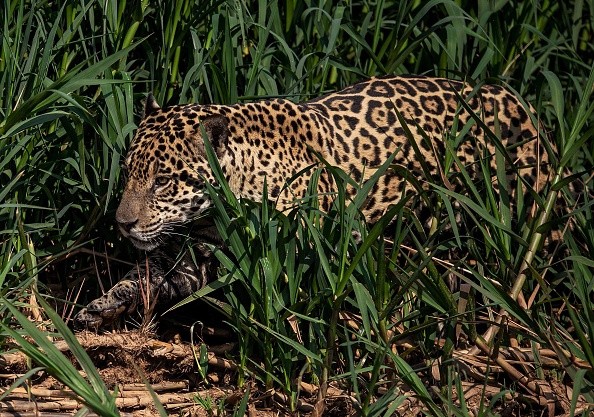
Brazilian scientist Fernando Tortato checks the bank for Ousado, a jaguar severely wounded in last year's horrific wildfires as he slowly rides upriver in a boat through the biggest tropical wetlands in the world - the Pantanal.
With his binoculars, naturalist Roberto Eduardo Stofel monitors a newborn harpy eagle sitting alone in a large nest, its parents evidently off seeking more difficult-to-find food.

Destruction of the Amazon Threatens Jaguars and Giant Eagles
Two of the most iconic species facing threats due to Amazon's increasing destruction are the sleek, majestic jaguar and the impressively strong harpy eagle. The Amazon's biodiversity is on the verge of collapse as the world's largest rainforest gets closer to a "tipping point."
According to scientists, this is the point at which a virtuous circle of deforestation, wildfires, and climate change may cause the rainforest to die out and change into a savannah, destroying its three million plant and animal species.
The effect is already being felt by the jaguar and the harpy eagle. Ousado, a four-year-old male weighing 75 kilograms (165 pounds), was injured a year ago when flames ravaged the Pantanal, exacerbated by the region's worst drought in 47 years.
The region, which is situated just south of the Amazon, is famous for its rich biodiversity, which draws tourists from all over the world to the area. But most of the region was burnt last year, killing or injuring many animals, including Ousado.
Animal hospital staff took the enormous black-and-yellow spotted cat in for treatment before releasing him out into the wild with a monitoring collar to keep an eye on how he is responding to treatment. Fortunately, the animal is showing signs of improvement.
The jaguar, the Americas' largest cat, is classified as "near threatened" and maintains a stronghold in the Amazon. Over the last two decades, its population has decreased by an estimated 20 to 25 percent.
Also Read : Young Harpy Eagles in Brazil's Amazonian Forests Are Starving Due to Worsening Deforestation
Harpy Eagles Face Starvation
The harpy eagle, like the jaguar, is an apex predator in the Amazon, known for its gigantic size, scary claws, and tufts of feathers popping out Beethoven-like from its head.
Harpies, which may weigh up to 10 kilos, scan the canopy for food and then swoop in with deadly accuracy, capturing monkeys, sloths, and even tiny deer.
In spite of their hunting skill, they are at risk of going hungry. The gray and white eagles, who mate for life, require around two years to raise their young. They only have one eaglet at a time, but they require a large area to seek adequate food.
Harpy eagles are not equipped to forage for food outside of the forest, according to a new study, and are unable to live in places with more than 50% deforestation, which is becoming more prevalent along the Amazon's margins.
Protecting Biodiversity
Protecting the Amazon's vulnerable biodiversity, according to Cristiane Mazzetti of environmental organization Greenpeace, is critical-and not only for the benefit of the plants and animals.
The planet's capacity to produce food, oxygen, clean water, pollination, and a variety of other "ecosystem services" on which all life relies is dependent on nature's complex interconnected web.
Mazzetti said: "Biodiversity isn't something that can be resuscitated. It's important to protect it for our own survival."
Related Article : Scientists Gain Insights into the Ecology of Brazilian Fishing Jaguars
For more news, updates about jaguars, giant eagles and similar topics don't forget to follow Nature World News!
© 2025 NatureWorldNews.com All rights reserved. Do not reproduce without permission.





